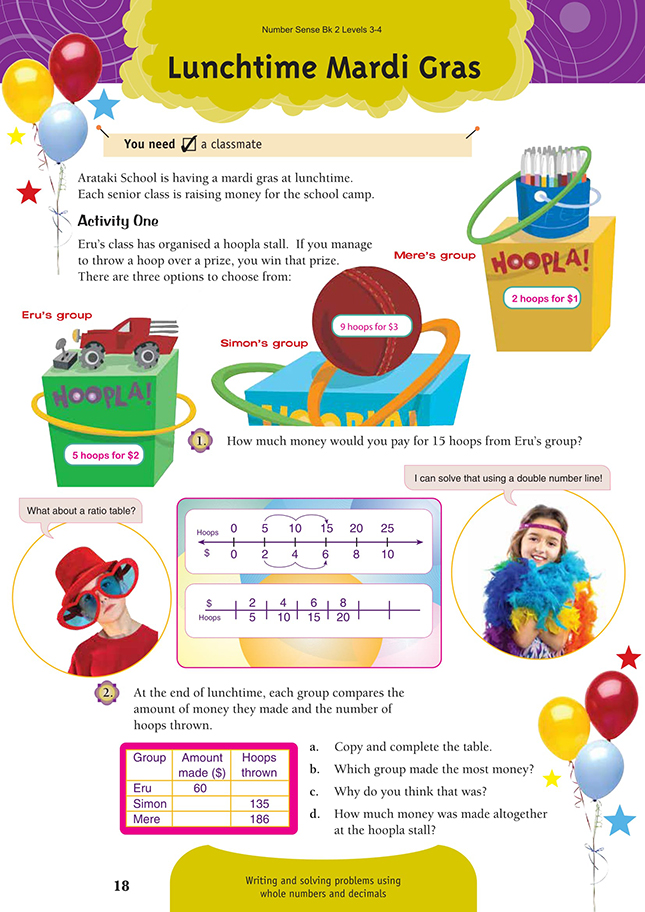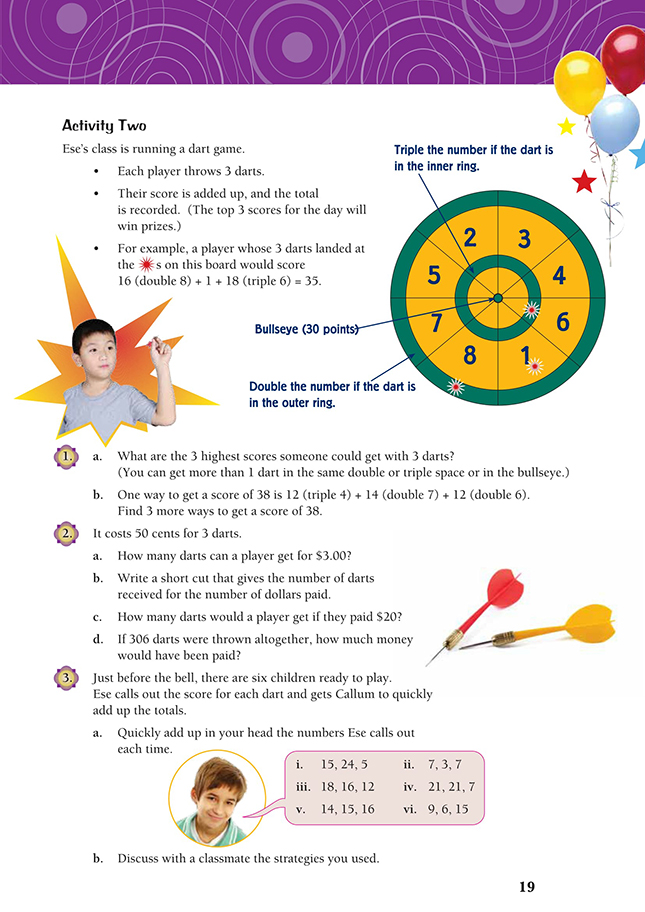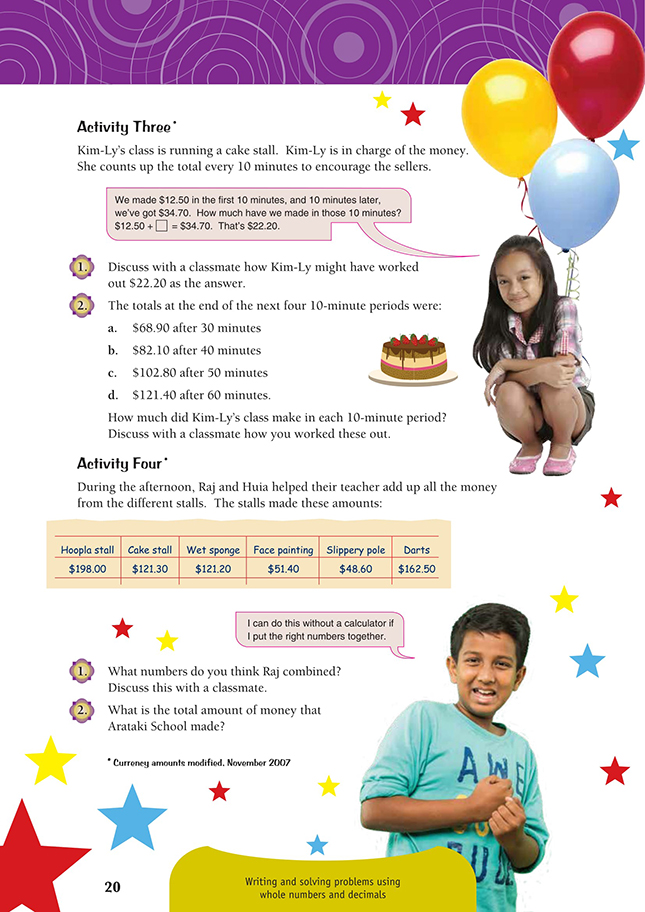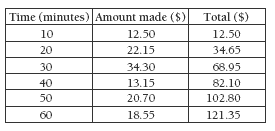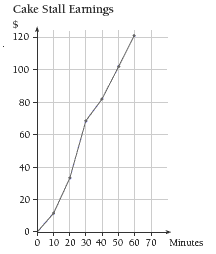This is a level 5 number activity from the Figure It Out series. It relates to Stage 8 of the Number Framework.
A PDF of the student activity is included.
Click on the image to enlarge it. Click again to close. Download PDF (610 KB)
solve problems involving rates
FIO, Levels 3-4, Number Sense and Algebraic Thinking, Book Two, Lunchtime Mardi Gras, pages 18-20
A classmate
In these activities, students write and solve problems involving whole numbers and decimals. They may use double number lines and ratio tables to find proportional relationships between measures and to apply equivalent ratios.
Activity One
In question 1, the students are given two visual methods to help them to solve a ratio problem: the double number line and the ratio table. These are used to compare the ratio of money to hoops. Eru’s group has a ratio of $2 : 5 hoops, so you would pay $6 for 15 hoops (tripling the ratio terms).
In question 2, the students can use the ratio table from question 1 and create other double number lines or ratio tables to answer the questions. Alternatively, they can apply the ratios directly to the problems and use appropriate strategies to solve them. Ask the students to explain their reasoning.For example:
“If $2 buys 5 hoops, $20 will buy 50 hoops and $60 will buy 3 x 50 = 150 hoops.”
“If $2 buys 5 hoops, $10 will buy 5 times as many, that’s 25 hoops, so $60 will buy
6 x 25 = 150 hoops.”
“If $3 buys 9 hoops, $15 will buy 45 hoops and $30 will buy 90 hoops. 45 + 90 = 135, so the cost of 135 hoops must be 15 + 30 = $45.”
To reinforce the mathematics, you could get each student to make up another table to show dollars and hoops, put new figures in the last two rows, and get a classmate to complete it.
The students need to summarise their findings. They should find that Mere’s group made the most money. Get them to clarify their ideas with a classmate so that they can say why they think Mere’s group made the most money. A possible explanation is: “For $1, Mere gave 2 hoops, Simon gave 3, and Eru gave 2 1/2, so Simon’s stall gave you the best chance of winning. However, Mere’s basic charge was only $1 compared with Simon’s basic charge of $3, so Mere’s stall may have appeared
cheaper or appealed more to students who wanted to try the hoopla activity without spending too much money.”
Activity Two
This activity involves the use of a dartboard. Make sure the students understand how the doubles and triples are scored. If possible, show this on a real dartboard.
In question 2a, the students could use the idea of ratio tables from Activity One to find out how many darts a player can get for $3.
(The table could also be set out vertically.)
This ratio table could help the students establish a rule that the total number of darts = 6 x number of dollars. So if $20 were paid (question 2c), the total number of darts would be 6 x 20 or 120 darts, and if 306 darts were thrown (question 2d), the cost in dollars would be 306 ÷ 6 = $51.
In question 3, the students have to justify the strategies they use to add up a combination of scores. These part–whole strategies could be based on tidy or compatible numbers for addition and on derived facts for multiplication.
The students need to be able to explain their strategy and why they chose it. Ask them to give another combination of three numbers for which a particular strategy would also be appropriate.
Extension
If possible, give the students practical experience in the game itself on a real dartboard, which is much more complex than the simplified one shown in the students’ book. This would allow the students to combine larger numbers using doubles and trebles than they can with the simplified model in the students’ book.
Activity Three
This activity requires the students to calculate how much money was made on the cake stall every 10 minutes. (This is known as a rate because money and time are measured in different units.) The students could display their work as a table.
Again, the question asks the students to explain the process they used to get their answers. Place value or tidy number strategies will work in either case. In difference problems like this, adding on (reversing) is usually an efficient mental strategy. For example, between 30 and 40 minutes, the difference is $82.10 – $68.95.
This can be calculated as:

Extension
The students could represent the money total on a time-series graph, showing the time in minutes on the horizontal axis and the total amount of money (cumulative total) made on the vertical axis.
The students could then use the visual representation to discuss the rate of sales in terms of the slope of the line at 10-minute intervals, that is, the steeper the slope, the more sales; and also whether the sales slowed down and for what possible reason. They could use this information to plan for next year’s mardi gras, for example, When would it be best to have most helpers at the cake stall?
Activity Four
This is another activity about combining tidy numbers in addition. The students will have various answers and may combine strategies, such as:
• add the cents: (35 + 15 + 50) + (35 + 65) = $2 (to make whole dollars),
• 198 + 2 = $200 (make a hundred),
• 121 + 121 = $242 (doubles),
• (160 + 40) + (8 +2) = $210 (make 100, make 10),
• then combine the subtotals and $51 to make $703.
See the Answers for another possible combination of strategies.
Answers to Activities
Activity One
1. $6
2. a.
b. Mere’s group
c. Although Mere’s group charged more per hoop, their basic charge of $1 was less than the other groups charged. This may have attracted more people to their group.
d. $198. (60 + 45 + 93)
Activity Two
1. a. 90 (3 bullseyes), 84 (2 bullseyes and a triple 8), 81 (2 bullseyes and a triple 7)
b. Answers will vary. For example, 21 (triple 7) + 12 (double 6) + 5,
24 (triple 8) + 9 (triple 3) + 5, or 6 + 18 (triple 6) + 14 (double 7)
2. a. 18. (6 x 3)
b. A possible rule is: number of darts = 6 x number of dollars paid.
c. 120 darts. (20 x 6)
d. $51. (306 ÷ 6)
3. a.–b. Answers and some possible strategies are:
i. 44. Possible strategy: compatible numbers (5 + 15)
ii. 17. Possible strategies: compatible numbers (7 + 3) or double 7
iii. 46. Possible strategies: compatible or tidy numbers (using 18 + 12 for both)
iv. 49. Possible strategies: double 21 or place value (20 x 2 + 1 x 2 + 7)
v. 45. Possible strategies: compatible or tidy numbers (14 + 16), compensation
(3 x 15)
vi. 30. Possible strategy: known facts (9 + 6 = 15) and double 15
Activity Three
1. Answers will vary. For example: $12.50 doubled is $25. 25 + 10 = $35, which is 35 cents more than $34.65. So $12.50 + $10 – 35c = $22.15.
(12.50 + 12.50 + 10 – 0.35 = $34.65)
2. Strategies will vary. Answers and a possible strategy for each are:
a. $34.30. 68.95 – 34.65 = or 34.65 + = 68.95.
0.35 + 30 + 4 – 0.05 = $34.30
b. $13.15. 82.10 – 68.95 = 82 – 70 + 0.1 + 1.05 = $13.15
(Using tidy numbers and compensation)
c. $20.70. 102.80 – 82.10: 102 – 82 = 20 and 0.80 – 0.10 = 0.70. 20 + 0.70 = $20.70 (Using place value)
d. $18.55. 121.35 – 102.80
= 122 – 102 – 0.65 – 0.80
= 20 – 1.45
= 18.55
(Using tidy numbers and compensation)
Activity Four
1. Answers may vary. Possible combinations include:
48.65 + 51.35 = $100
121.35 + 121.15 = $242.50
162.50 + 242.50 = $405.00. (100 + 200 = 300 and 62 + 42 = 104; 300 + 104 + 1 = $405.00)
Then 405 + 100 = $505; 198 = 200 – 2, so 505 + 198 = 505 + 200 – 2
= 705 – 2
= $703
2. $703
